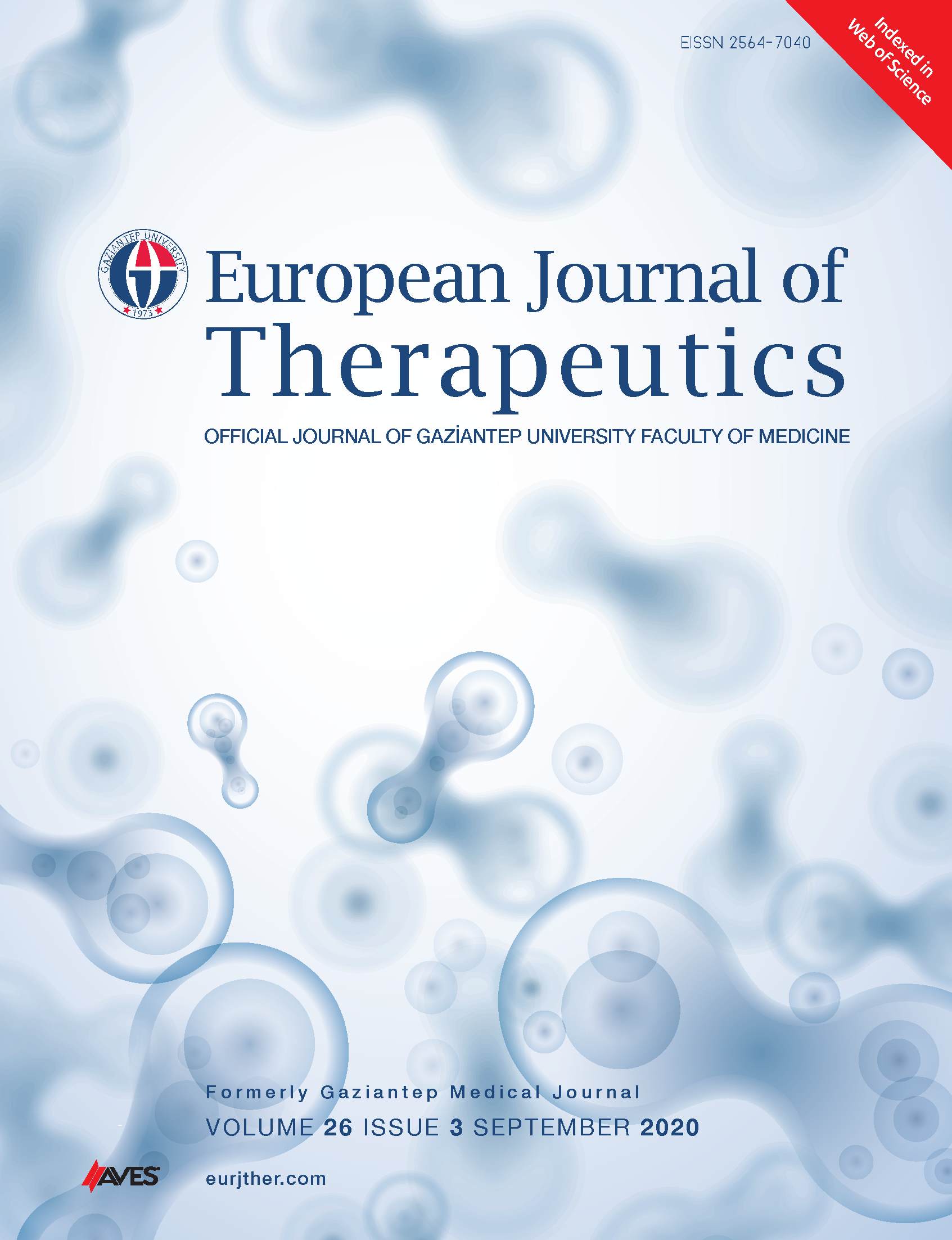The Neutrophil to Lymphocyte Ratio and In-Hospital All-Cause Mortality in Patients with COVID-19
DOI:
https://doi.org/10.5152/eurjther.2020.20067Keywords:
Coronavirus, lymphocyte, neutrophilAbstract
Objective: In December 2019, pneumonia associated with severe acute respiratory syndrome coronavirus 2 emerged in China, and has been spread worldwide eventuating the coronavirus disease 2019 (COVID-19) pandemic. As of June 27, 2020, 195,883 people have been diagnosed with COVID-19 in Turkey, among them 5082 are dead. Moreover, 9,999,606 people were infected worldwide. The neutrophil-to-lymphocyte ratio (NLR) has been reported as an inflammatory biomarker. This study aimed to evaluate the relationship between NLR on admission and in-hospital all-cause mortality in adult patients with COVID-19.
Methods: This retrospective cohort study included a total of 455 COVID-19 patients from Turkey. The diagnosis of COVID-19 was made according to the World Health Organization’s interim guidance and confirmed by RNA detection of SARS-CoV-2. The NLR was calculated for each patient.
Results: The NLR on admission was found to be significantly higher in nonsurvivor COVID-19 patients than survivors (12.3 [0.8– 137.3] vs. 3.2 [0.6–79.0], p<0.001). Forward stepwise logistic regression analysis was carried out to determine the independent predictors of in-hospital all-cause mortality of patients with COVID-19. The analysis demonstrated that age [odds ratio (OR)=1.203, 95% confidence interval (CI): 1.027–1.408, p=0.022], NLR (OR=1.261, 95% CI: 1.054–1.509, p=0.011), lactate dehydrogenase level (OR=1.013, 95% CI: 1.004–1.022, p=0.005), glomerular filtration rate (OR=0.920, 95% CI: 0.853–0.992, p=0.030), alanine transaminase level (OR=1.107, 95% CI: 1.011–1.212, p=0.028), and aspartate transaminase level on admission (OR=0.939, 95% CI: 0.888– 0.993, p=0.027) were independent predictors of in-hospital all-cause mortality of patients with COVID-19. In the receiver operating characteristic curve analysis, the sensitivity and specificity of the NLR for predicting in-hospital all-cause mortality were found to be 92% and 53%, respectively, at the cut-off value of 3.
Conclusion: The NLR on admission predicts in-hospital all-cause mortality of patients with COVID-19.
Metrics
References
Zhu N, Zhang D, Wang W, Li X, Yang B, Song J, et al. A Novel Coronavirus from Patients with Pneumonia in China, 2019. N Engl J Med 2020; 382: 727-33.
Faria SS, Fernandes Jr PC, Silva MJ, Lima VC, Fontes W, Freitas-Junior R, et al. The neutrophil-to-lymphocyte ratio: a narrative review. Ecancermedicalscience 2016; 10: 702.
Imtiaz F, Shafique K, Mirza SS, Ayoob Z, Vart P, Rao S. Neutrophil lymphocyte ratio as a measure of systemic inflammation in prevalent chronic diseases in Asian population. Int Arch Med 2012; 5: 2.
de Jager CP, Wever PC, Gemen EF, Kusters R, van Gageldonk-Lafeber AB, van der Poll T, et al. The neutrophil-lymphocyte count ratio in patients with community-acquired pneumonia. PLoS One 2012; 7: e46561.
Curbelo J, Rajas O, Arnalich B, Galvan-Roman JM, Luquero-Bueno S, Ortega-Gomez M, et al. Neutrophil Count Percentage and Neutrophil-Lymphocyte Ratio as Prognostic Markers in Patients Hospitalized for Community-Acquired Pneumonia. Arch Bronconeumol 2019; 55: 472-7.
Kaushik R, Gupta M, Sharma M, Jash D, Jain N, Sinha N, et al. Diagnostic and Prognostic Role of Neutrophil-to-Lymphocyte Ratio in Early and Late Phase of Sepsis. Indian J Crit Care Med 2018; 22: 660- 3.
Liu Y, Du X, Chen J, Jin Y, Peng L, Wang HHX, et al. Neutrophil-to-lymphocyte ratio as an independent risk factor for mortality in hospitalized patients with COVID-19. J Infect 2020; 81: e6-e12.
Liu J, Liu Y, Xiang P, Pu L, Xiong H, Li C, et al. Neutrophil-to-lymphocyte ratio predicts critical illness patients with 2019 coronavirus disease in the early stage. J Transl Med 2020; 18: 206.
Qin C, Zhou L, Hu Z, Zhang S, Yang S, Tao Y, et al. Dysregulation of immune response in patients with COVID-19 in Wuhan, China. Clin Infect Dis 2020; 71: 762-8.
Mo P, Xing Y, Xiao Y, Deng L, Zhao Q, Wang H, et al. Clinical characteristics of refractory COVID-19 pneumonia in Wuhan, China. Clin Infect Dis 2020.
Channappanavar R, Perlman S. Pathogenic human coronavirus infections: causes and consequences of cytokine storm and immunopathology. Semin Immunopathol 2017; 39: 529-39.
He Z, Zhao C, Dong Q, Zhuang H, Song S, Peng G, et al. Effects of severe acute respiratory syndrome (SARS) coronavirus infection on peripheral blood lymphocytes and their subsets. Int J Infect Dis 2005; 9: 323-30.
Min CK, Cheon S, Ha NY, Sohn KM, Kim Y, Aigerim A, et al. Comparative and kinetic analysis of viral shedding and immunological responses in MERS patients representing a broad spectrum of disease severity. Sci Rep 2016; 6: 25359.
Al-Tawfiq JA, Hinedi K, Abbasi S, Babiker M, Sunji A, Eltigani M. Hematologic, hepatic, and renal function changes in hospitalized patients with Middle East respiratory syndrome coronavirus. Int J Lab Hematol 2017; 39: 272-8.
Huang C, Wang Y, Li X, Ren L, Zhao J, Hu Y, et al. Clinical features of patients infected with 2019 novel coronavirus in Wuhan, China. Lancet 2020; 395: 497-506.
Zhou F, Yu T, Du R, Fan G, Liu Y, Liu Z, et al. Clinical course and risk factors for mortality of adult inpatients with COVID-19 in Wuhan, China: a retrospective cohort study. Lancet 2020; 395: 1054-62.
Ruan Q, Yang K, Wang W, Jiang L, Song J. Clinical predictors of mortality due to COVID-19 based on an analysis of data of 150 patients from Wuhan, China. Intensive Care Med 2020; 46: 846-8.
Wang D, Hu B, Hu C, Zhu F, Liu X, Zhang J, et al. Clinical Characteristics of 138 Hospitalized Patients With 2019 Novel Coronavirus-Infected Pneumonia in Wuhan, China. JAMA 2020; 323: 1061-9.
Zhang J, Wang X, Jia X, Li J, Hu K, Chen G, et al. Risk factors for disease severity, unimprovement, and mortality of COVID-19 patients in Wuhan, China. Clin Microbiol Infect 2020; 26: 767-72.
Downloads
Published
How to Cite
Issue
Section
License
Copyright (c) 2023 European Journal of Therapeutics

This work is licensed under a Creative Commons Attribution-NonCommercial 4.0 International License.
The content of this journal is licensed under a Creative Commons Attribution-NonCommercial 4.0 International License.


















